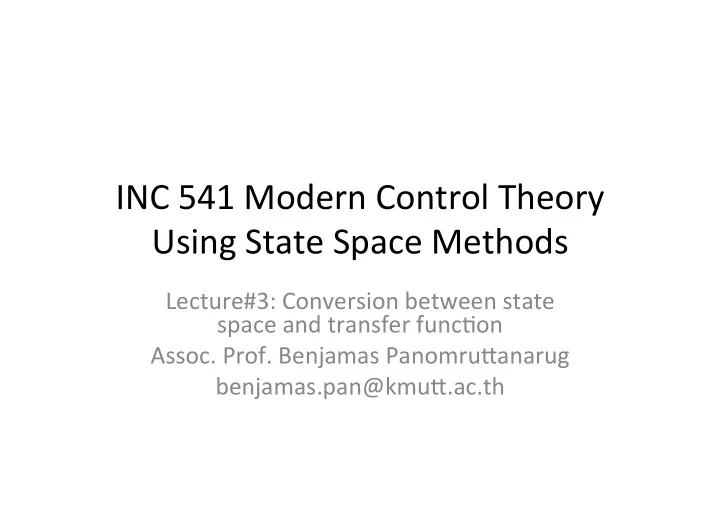

INC ¡541 ¡Modern ¡Control ¡Theory ¡ Using ¡State ¡Space ¡Methods Lecture#3: ¡Conversion ¡between ¡state ¡ space ¡and ¡transfer ¡funcDon ¡ Assoc. ¡Prof. ¡Benjamas ¡PanomruKanarug ¡ benjamas.pan@kmuK.ac.th
TransformaDon ¡of ¡state ¡variables • Original ¡system: ¡ • Linear ¡transformaDon: ¡ • An ¡equivalent ¡system ¡(idenDcal ¡output ¡from ¡ the ¡same ¡input): BP INC541 2
Example From ¡the ¡previous ¡example, ¡the ¡state ¡variables ¡ are ¡ ¡ If ¡we ¡define ¡the ¡new ¡state ¡variables ¡as ¡ ¡ BP INC541 3
• TransformaDon: ¡ • Equivalent ¡state ¡space ¡model: BP INC541 4
TransformaDon ¡using ¡eigenvectors ¡ BP INC541 5
Example ¡5.8 ¡ BP INC541 6
Example ¡5.9 ¡ BP INC541 7
Example ¡5.9 ¡(cont.) ¡ BP INC541 8
Conversion ¡of ¡state ¡variable ¡ models ¡to ¡transfer ¡funcDons ¡ ConDnuous ¡Dme ¡ BP INC541 9
Conversion ¡of ¡state ¡variable ¡models ¡to ¡ transfer ¡funcDons Laplace ¡transform ¡ ¡ ¡ ¡ ¡ For ¡zero ¡iniDal ¡state ¡ BP INC541 10
Example ¡to ¡change ¡a ¡SS ¡model ¡to ¡TF Find ¡the ¡transfer ¡funcDon ¡of ¡the ¡SS ¡model: BP INC541 11
Invariance ¡property ¡of ¡a ¡ transformaDon ¡ BP INC541 12
Invariance ¡property ¡of ¡a ¡ transformaDon ¡(cont.) ¡ BP INC541 13
Conversion ¡of ¡transfer ¡funcDons ¡to ¡ state ¡space ¡models BP INC541 14
Conversion ¡of ¡transfer ¡funcDons ¡to ¡ state ¡variable ¡models ¡ There ¡are ¡3 ¡types ¡of ¡canonical ¡form: ¡ • First ¡companion ¡form ¡ • Second ¡companion ¡form ¡ • Jordan ¡form BP INC541 15
First ¡companion ¡form • Consider ¡a ¡transfer ¡funcDon: ¡ • IdenDfy ¡a ¡new ¡state ¡variable ¡as ¡an ¡output ¡of ¡ each ¡integrator BP INC541 16
First ¡companion ¡form ¡(cont.) • State ¡variables: ¡ • State ¡space ¡model: BP INC541 17
Second ¡companion ¡form BP INC541 18
Comparison ¡bt. ¡First ¡and ¡second ¡ companion ¡forms • First ¡companion ¡form • Second ¡companion ¡form BP INC541 19
Eigenvalue ¡vs. ¡system ¡pole ¡ • The ¡system ¡has ¡3 ¡poles ¡at ¡ • State ¡space ¡model ¡of ¡the ¡system: ¡ ¡ Poles ¡are ¡equal ¡to ¡the ¡eigenvalues ¡of ¡A!!! BP INC541 20
Jordan ¡form • Case ¡I: ¡disDnct ¡poles ¡ ¡ ¡ ¡ ¡ Long ¡division: ¡ ¡ ¡ ¡ ParDal ¡fracDon: ¡ ¡ ¡ ¡ ¡ BP INC541 21
Jordan ¡form ¡(cont.) ¡ State ¡space ¡model: ¡ BP INC541 22
Jordan ¡form ¡(cont.) • Case ¡II: ¡repeated ¡poles ¡ • G(s) ¡has ¡m ¡disDnct ¡poles ¡at ¡ ¡ ¡ ¡ ¡ ¡ ¡ ¡ ¡ ¡ ¡ ¡ ¡ ¡ ¡ ¡ ¡ ¡ ¡ ¡ ¡ ¡ ¡ ¡of ¡ s , , … , = λ λ λ 1 2 m mulDplicity ¡ ¡ n , n , … , n 1 2 m ¡ParDal ¡fracDon ¡expansion ¡of ¡G(s): BP INC541 23
Jordan ¡form ¡(cont.) ¡ • For ¡each ¡subsystem ¡having ¡the ¡same ¡pole BP INC541 24
Jordan ¡form ¡(cont.) • For ¡each ¡subsystem ¡having ¡the ¡same ¡pole Poles ¡are ¡arranged ¡in ¡the ¡main ¡diagonal BP INC541 25
Jordan ¡form ¡(cont.) • Overall ¡system BP INC541 26
Example Find ¡the ¡3 ¡different ¡realizaDons ¡for ¡ ¡ ¡ ¡ • First ¡companion: ¡ BP INC541 27
• Second ¡companion ¡ • Jordan ¡form BP INC541 28
Matlab ¡funcDons ¡ • ^2ss ¡ • ss2^ ¡ • canon ¡ • jordan ¡ BP INC541 29
Recommend
More recommend